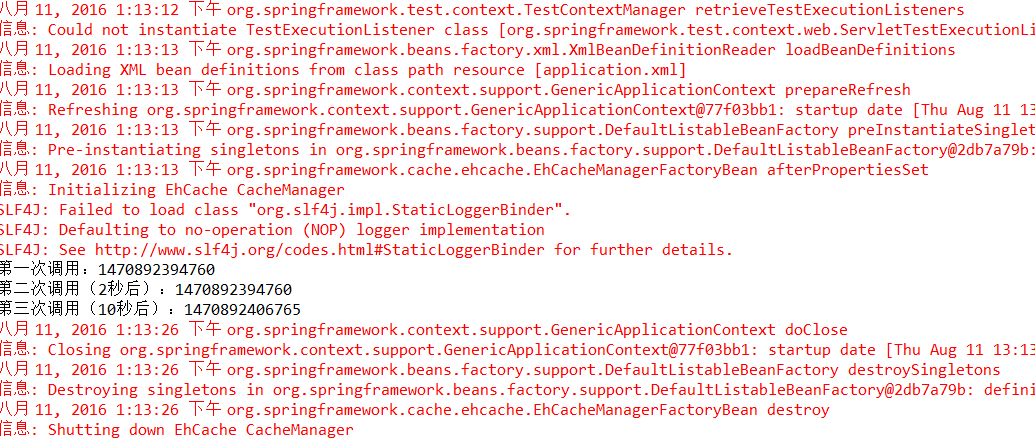Ehcache缓存入门实战(附源码)
Ehcache是一个强大、成熟的Java缓存框架,可以非常容易与其他库和框架集成。官网声称Ehcache可以作为TB级别的数据缓存,并且具有高扩展性。目前Ehcache的最新版本是3.1。
本文不会深究缓存背后的原理,只是作为一个使用Ehcache的例子,由于最近需要做一个类似二级缓存的功能,特地学习了下Ehcache。发现Ehcache作为一个本地缓存框架使用还是非常合适的,但是如果扩展到分布式缓存就需要考虑使用Redis这样的分布式缓存框架了。
为了快速入门,这里使用配置文件的方式整合Ehcache。
创建Maven工程,添加pom.xml依赖如下:
<project xmlns="http://maven.apache.org/POM/4.0.0" xmlns:xsi="http://www.w3.org/2001/XMLSchema-instance" xsi:schemaLocation="http://maven.apache.org/POM/4.0.0 http://maven.apache.org/xsd/maven-4.0.0.xsd"> <modelVersion>4.0.0</modelVersion> <groupId>com.rhwayfun</groupId> <artifactId>ehcache-demo</artifactId> <version>0.0.1-SNAPSHOT</version> <name>ehcache-demo</name> <description>ehcache-demo</description> <properties> <!-- 项目编码 --> <project.build.sourceEncoding>UTF-8</project.build.sourceEncoding> <!-- junit版本号 --> <junit.version>4.12</junit.version> <!-- spring版本号 --> <spring.version>3.2.8.RELEASE</spring.version> </properties> <dependencies> <!-- 添加单元测试依赖 --> <dependency> <groupId>junit</groupId> <artifactId>junit</artifactId> <version>${junit.version}</version> </dependency> <!-- 添加Spring依赖 --> <dependency> <groupId>org.springframework</groupId> <artifactId>spring-core</artifactId> <version>${spring.version}</version> </dependency> <dependency> <groupId>org.springframework</groupId> <artifactId>spring-webmvc</artifactId> <version>${spring.version}</version> </dependency> <dependency> <groupId>org.springframework</groupId> <artifactId>spring-context</artifactId> <version>${spring.version}</version> </dependency> <dependency> <groupId>org.springframework</groupId> <artifactId>spring-context-support</artifactId> <version>${spring.version}</version> </dependency> <dependency> <groupId>org.springframework</groupId> <artifactId>spring-aop</artifactId> <version>${spring.version}</version> </dependency> <dependency> <groupId>org.springframework</groupId> <artifactId>spring-aspects</artifactId> <version>${spring.version}</version> </dependency> <dependency> <groupId>org.springframework</groupId> <artifactId>spring-tx</artifactId> <version>${spring.version}</version> </dependency> <dependency> <groupId>org.springframework</groupId> <artifactId>spring-jdbc</artifactId> <version>${spring.version}</version> </dependency> <dependency> <groupId>org.springframework</groupId> <artifactId>spring-web</artifactId> <version>${spring.version}</version> </dependency> <!--spring单元测试依赖 --> <dependency> <groupId>org.springframework</groupId> <artifactId>spring-test</artifactId> <version>${spring.version}</version> <scope>test</scope> </dependency> <!-- ehcache 相关依赖 --> <dependency> <groupId>net.sf.ehcache</groupId> <artifactId>ehcache</artifactId> <version>2.8.2</version> </dependency> </dependencies></project>
- 1
- 2
- 3
- 4
- 5
- 6
- 7
- 8
- 9
- 10
- 11
- 12
- 13
- 14
- 15
- 16
- 17
- 18
- 19
- 20
- 21
- 22
- 23
- 24
- 25
- 26
- 27
- 28
- 29
- 30
- 31
- 32
- 33
- 34
- 35
- 36
- 37
- 38
- 39
- 40
- 41
- 42
- 43
- 44
- 45
- 46
- 47
- 48
- 49
- 50
- 51
- 52
- 53
- 54
- 55
- 56
- 57
- 58
- 59
- 60
- 61
- 62
- 63
- 64
- 65
- 66
- 67
- 68
- 69
- 70
- 71
- 72
- 73
- 74
- 75
- 76
- 77
- 78
- 79
- 80
- 81
- 82
- 83
- 84
- 85
- 86
- 87
- 88
- 89
添加Spring配置:application.xml
<?xml version="1.0" encoding="UTF-8"?><beans xmlns="http://www.springframework.org/schema/beans" xmlns:xsi="http://www.w3.org/2001/XMLSchema-instance" xmlns:cache="http://www.springframework.org/schema/cache" xmlns:context="http://www.springframework.org/schema/context" xmlns:aop="http://www.springframework.org/schema/aop" xsi:schemaLocation=" http://www.springframework.org/schema/beans http://www.springframework.org/schema/beans/spring-beans-3.0.xsd http://www.springframework.org/schema/aop http://www.springframework.org/schema/aop/spring-aop-3.0.xsd http://www.springframework.org/schema/context http://www.springframework.org/schema/context/spring-context-3.0.xsd http://www.springframework.org/schema/cache http://www.springframework.org/schema/cache/spring-cache-3.1.xsd"> <!-- 自动扫描注解的bean --> <context:component-scan base-package="com.rhwayfun.ehcache.service.impl" /> <cache:annotation-driven cache-manager="cacheManager" /> <bean id="cacheManager" class="org.springframework.cache.ehcache.EhCacheCacheManager"> <property name="cacheManager" ref="ehcache"></property> </bean> <bean id="ehcache" class="org.springframework.cache.ehcache.EhCacheManagerFactoryBean"> <property name="configLocation" value="classpath:ehcache.xml"></property> </bean></beans>
- 1
- 2
- 3
- 4
- 5
- 6
- 7
- 8
- 9
- 10
- 11
- 12
- 13
- 14
- 15
- 16
- 17
- 18
- 19
- 20
- 21
- 22
- 23
- 24
- 25
- 26
- 27
- 28
- 29
还需要Ehcache的配置文件:ehcache.xml
<?xml version="1.0" encoding="UTF-8"?><ehcache> <!-- 指定一个文件目录,当EhCache把数据写到硬盘上时,将把数据写到这个文件目录下 --> <diskStore path="java.io.tmpdir"/> <!-- 设定缓存的默认数据过期策略 --> <!-- 参数说明: name:缓存名称 maxElementsInMemory:内存中最大的缓存对象数 eternal:true表示对象永不过期 overflowToDisk:true表示当内存缓存的对象数达到maxElementsInMemory后,会把溢出的对象写到硬盘缓存中。(ps:如果需要写到磁盘中,则写入的对象必须实现Serializable接口) timeToIdleSeconds:设定允许对象处于空闲状态的最长时间,以秒为单位。(ps:这个属性只有当eternal属性为false才有效) timeToLiveSeconds:设定对象允许存在于缓存中的最大生存时间,以秒为单位。(ps:这个属性只有当eternal属性为false才有效) diskPersistent:是否缓存虚拟机重启期数据,是否持久化磁盘缓存,当这个属性的值为true时,系统在初始化时会在磁盘中查找文件名为cache名称, 后缀名为index的文件,这个文件中存放了已经持久化在磁盘中的cache的index,找到后会把cache加载到内存,要想把cache真正持久化到磁盘,写程 序时注意执行net.sf.ehcache.Cache.put(Element element)后要调用flush()方法。 diskExpiryThreadIntervalSeconds:磁盘失效线程运行时间间隔,默认为120秒 --> <defaultCache maxElementsInMemory="10000" eternal="false" overflowToDisk="true" timeToIdleSeconds="10" timeToLiveSeconds="20" diskPersistent="false" diskExpiryThreadIntervalSeconds="120"/> <cache name="cacheTest" maxElementsInMemory="1000" eternal="false" overflowToDisk="true" timeToIdleSeconds="10" timeToLiveSeconds="20"/></ehcache>
- 1
- 2
- 3
- 4
- 5
- 6
- 7
- 8
- 9
- 10
- 11
- 12
- 13
- 14
- 15
- 16
- 17
- 18
- 19
- 20
- 21
- 22
- 23
- 24
- 25
- 26
- 27
- 28
- 29
- 30
- 31
- 32
- 33
- 34
- 35
- 36
在代码中已经对具体的参数含义做了说明,这里不再赘述。这里要注意的是name属性,在后面的测试代码需要使用到它。
编写测试接口:
package com.rhwayfun.ehcache.service;/** * * @ClassName: EhcacheService * @Description: TODO * @author ZhongCB * @date 2016年8月11日 上午11:53:52 * */public interface EhcacheService { String getTime(String param);}
- 1
- 2
- 3
- 4
- 5
- 6
- 7
- 8
- 9
- 10
- 11
- 12
- 13
- 14
- 15
接口实现类:
package com.rhwayfun.ehcache.service.impl;import org.springframework.cache.annotation.Cacheable;import org.springframework.stereotype.Service;import com.rhwayfun.ehcache.service.EhcacheService;@Servicepublic class EhcacheServiceImpl implements EhcacheService { @Cacheable(value = "cacheTest", key="#param") public String getTime(String param) { return String.valueOf(System.currentTimeMillis()); }}
- 1
- 2
- 3
- 4
- 5
- 6
- 7
- 8
- 9
- 10
- 11
- 12
- 13
- 14
- 15
- 16
- 17
注意@Cacheable注解的value属性的值就是ehcache.xml配置文件中的name属性的值。key表示方法的参数param代表的就是缓存的key,通过这个key可以获取到value。
最后编写测试代码:
package com.rhwayfun.test;import org.junit.Test;import org.junit.runner.RunWith;import org.springframework.beans.factory.annotation.Autowired;import org.springframework.test.context.ContextConfiguration;import org.springframework.test.context.junit4.AbstractJUnit4SpringContextTests;import org.springframework.test.context.junit4.SpringJUnit4ClassRunner;import com.rhwayfun.ehcache.service.EhcacheService;@ContextConfiguration(locations = {"classpath:application.xml"})@RunWith(SpringJUnit4ClassRunner.class)public class EhcacheTest extends AbstractJUnit4SpringContextTests{ @Autowired private EhcacheService ehcacheService; @Test public void testEhcache() throws InterruptedException{ System.out.println("第一次调用:" + ehcacheService.getTime("param")); Thread.sleep(2000); System.out.println("第二次调用(2秒后):" + ehcacheService.getTime("param")); Thread.sleep(10000); System.out.println("第三次调用(10秒后):" + ehcacheService.getTime("param")); }}
- 1
- 2
- 3
- 4
- 5
- 6
- 7
- 8
- 9
- 10
- 11
- 12
- 13
- 14
- 15
- 16
- 17
- 18
- 19
- 20
- 21
- 22
- 23
- 24
- 25
- 26
- 27
- 28
运行该测试类,结果如下:
至此,Ehcache的入门实战就结束了,如果想要更详细了解Ehcache的资料,请访问Ehcache官网。
再分享一下我老师大神的人工智能教程吧。零基础!通俗易懂!风趣幽默!还带黄段子!希望你也加入到我们人工智能的队伍中来!https://blog.csdn.net/jiangjunshow
